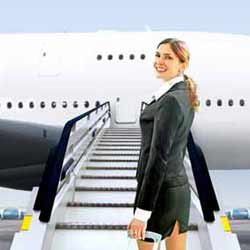Become a Flight Attendant
“Ladies and Gentlemen, please fasten your seatbelts, we will be landing in 5 minutes…” Could this be you? Do you love to fly and enjoy interacting with people?
Well, then you should look at how to become a flight attendant. As a flight attendant, you are the face of the airline you work for and give people a pleasant flight experience, as well as making sure that safety and security regulations are followed correctly, as a legal requirement. Flight attendant jobs are attractive to lots of people due to the travel aspect, which means that there is plenty of competition for these positions.

Your duties include checking that all the first aid kits are stocked and that emergency equipment is on board the plane and working correctly. You make sure that there are enough food and beverage supplies and other items to make the passengers’ flight comfortable. You are briefed by the pilot an hour before each flight regarding any special circumstances to do with the passengers, weather conditions, crew coordination, and the length of the flight, as well as any updated emergency evacuation protocols.
A flight attendant greets the passengers as they board and checks their tickets. They are also responsible for instructing the passengers on how to use the emergency equipment on the plane and ensure that seats are upright, seatbelts are fastened and that luggage is safely stowed away before taking off and landing. During flights, the flight attendants’ main job is to ensure the safety of the passengers and help them in any emergency. This includes administering first aid and comforting passengers during rough flight conditions.
Before landing, the flight attendants must take inventory of all alcoholic beverages, money, and on board items, and report any illnesses or problems that passengers may have had. There is a lead flight attendant, also known as a purser on board each flight to oversee all the other flight attendants whilst also performing the same duties.
To become a flight attendant, you may want to get flight attendant training, which is generally 3-6 weeks in duration. Most airlines offer in-house. A high school diploma is required, although many airlines nowadays prefer applicants who also have some sort of degree in education or hospitality, and experience working with the public. The training provided is specific to the type of aircraft, so if you want to change airlines at any stage, this is easy, with re-training being only 1 or 2 days. Airlines have specific physical appearance and age requirements. Flight attendant applicants are usually between the ages of 18 and 21 and have to be tall enough to reach overhead bins where emergency equipment is kept. Airlines also prefer healthy individuals with a weight proportionate to their height.
The flight training centers cover operating emergency equipment, learning evacuation procedures, administering first aid and water survival training. You should also be fluent in at least 2 other languages for international flights. The last step of training will be to take various tests which eliminate unsuccessful candidates, and perform various drills and tasks unaided. The final stage is to go on practice flights, after which you will receive the FAA (Federal Aviation Administration) Certificate of Demonstrated Proficiency.
Furthermore you have to pass a safety exam set out by the FAA and the Transportation Security Administration. Before being hired, the FAA also performs a 10 year background check on you and you have to undergo a medical examination to ensure that you are in excellent health with at least 20/30 corrected vision. Flight attendants then join unions like Transport Workers Union of America and the Association of Professional Flight Attendants.
Flight attendants work long hours, over weekends, and nights, and are away from home for long periods of time. A total monthly working time is agreed upon between airlines and employees, largely negotiated by the Association of Flight Attendants. Other employment regulations include scheduling 12 to 14 hour day with at least 9 hours of rest following a shift. Airlines pay extra for additional hours worked with other benefits including medical, dental, 401k plans, paid sick leave, stock options, tuition, life insurance, hotel board, meals while away from home, and discounted flights for immediate family.
Aside from working for large commercial airlines, flight attendants can also apply for jobs on private planes and for small corporate airlines.
Flight Attendant Salaries
Quick Flight Attendant Job Facts
Job Title: Flight Attendant
Office: Home base of the airline and in the air on board a plane
Description: A flight attendant is responsible for the comfort, safety and security of the passengers during a flight
Certifications/Education: 3-6 weeks of training is required, as well as FAA certification
Necessary Skills: Must be poised, able to reassure passengers, able to handle pressure and difficult situations with ease, and always have a pleasant manner no matter how tired or stressed you are
Potential Employers: Commercial airlines, corporate airlines, and private plane owners
Helpful Flight Attendant Employment Links:
Search Flight Attendant Jobs on JobMonkey
Federal Aviation Administration
Airline Job Finder
Best Aviation Flight Attendant Schools
Association of Flight Attendants – CWA United Master Executive Council
Transport Workers Union
Association of Professional Flight Attendants

